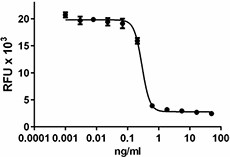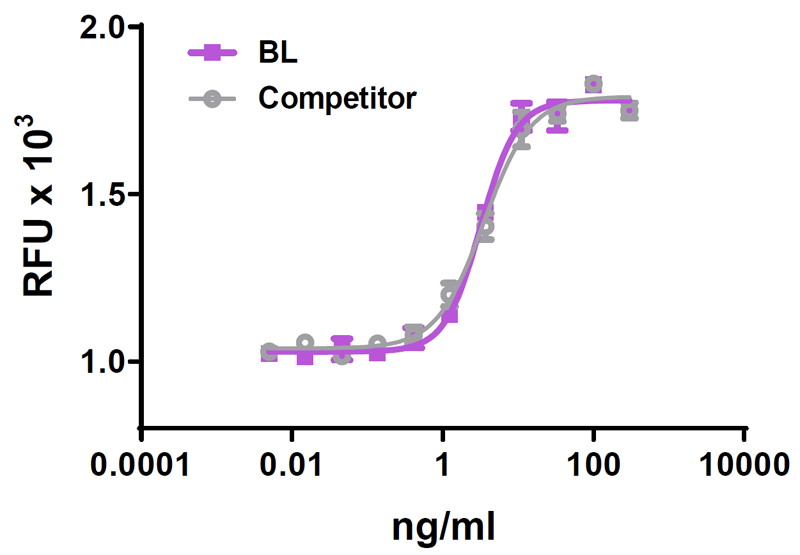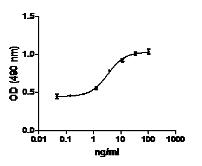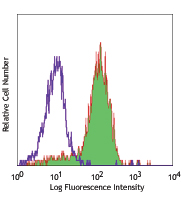- Regulatory Status
- RUO
- Other Names
- IL-15RA, CD215, Interleukin 15 receptor alpha chain
- Ave. Rating
- Submit a Review
| Cat # | Size | Price | Quantity Check Availability | Save | ||
|---|---|---|---|---|---|---|
| 761502 | 10 µg | 179€ | ||||
| 761504 | 25 µg | 254€ | ||||
| 761506 | 100 µg | 713€ | ||||
| 761508 | 500 µg | 1997€ | ||||
The IL-15R is a heterotrimeric complex that includes a beta subunit (IL-2R/15Rβ/CD122) shared with the IL-2 receptor, a common gamma subunit (γc/CD132) shared with IL-2, IL-4, IL-7, IL-9 and IL-21, and a unique alpha subunit (IL-15Rα) that confers receptor specificity to IL-15. IL-15Rα is structurally similar to IL-2Rα; the ectodomain of IL-15Rα consists of a single protein-binding Sushi domain (essential for IL-15/ IL-15Rα function) a membrane-proximal proline-threonine-rich (PT) region, and a linker/hinge region that connects the sushi domain and the PT region. IL-15Rα is widely expressed in mice and humans independently of IL-2R/IL-15Rβ-γc. IL-15Ra binds IL-15 with high affinity and in this way the cytokine is retained on the surface of the cells and trans-presented to IL-2R/15Rβ-γc on nearby effector NK and T cells. IL-15Rα and IL-15 play a key role in the development and homeostasis of memory CD8 T cells, natural killer cells, invariant NKT cells, and a subset of intestinal intraepithelial lymphocytes, as described by their significant deficiency in IL-15-deficient mice. In mast cells, IL-15R/IL-15 acts as a growth factor and an inhibitor of apoptosis. In addition, the complex IL-15R/IL-15 induces B lymphocyte proliferation, differentiation, and increases immunoglobulin secretion. A soluble form of human IL-15Ra arises from proteolytic shedding of the membrane-anchored receptor. It is released from IL-15Ra-expressing human cell lines. This release is strongly induced by PMA, ionomycin, and to a lesser extent by IL-1b and TNFa. Abnormal expression of both IL-15Rα and IL-15 is associated with the pathogenesis of celiac disease. Also, high levels of soluble IL-15Rα are detected in serum of patients with T cell large granular lymphocyte leukemia.
Product DetailsProduct Details
- Source
- Human IL-15Rα, amino acids (Ile31-Thr205) (Accession# Q13261) was expressed in 293E cells. The C-terminus contains SR-IEGRMD-hIgG1-FC-tag.
- Molecular Mass
- The 414 amino acid recombinant protein has a predicted molecular mass of approximately 45.2 kD. The DTT-reduced and non-reduced protein migrate at approximately 70 — 80 kD and 140 kD respectively by SDS-PAGE. The predicted N-terminal amino acid is Ile.
- Purity
- >95% as determined by Coomassie stained SDS-PAGE.
- Formulation
- 0.22 µm filtered protein solution is in PBS, pH 7.2.
- Endotoxin Level
- Less than 0.01 EU per µg cytokine as determined by the LAL method.
- Concentration
- 10 and 25 µg sizes are bottled at 200 µg/mL. 100 µg size and larger sizes are lot-specific and bottled at the concentration indicated on the vial. To obtain lot-specific concentration and expiration, please enter the lot number in our Certificate of Analysis online tool.
- Storage & Handling
- Unopened vial can be stored between 2°C and 8°C for up to 2 weeks, at -20°C for up to six months, or at -70°C or colder until the expiration date. For maximum results, quick spin vial prior to opening. The protein can be aliquoted and stored at -20°C or colder. Stock solutions can also be prepared at 50 - 100 µg/mL in appropriate sterile buffer, carrier protein such as 0.2 - 1% BSA or HSA can be added when preparing the stock solution. Aliquots can be stored between 2°C and 8°C for up to one week and stored at -20°C or colder for up to 3 months. Avoid repeated freeze/thaw cycles.
- Activity
- Human IL-15Rα inhibits the HT-2 cell proliferation induced by human IL-15 at 0.25 ng/ml. The ED50 = 0.15 — 0.75 ng/ml.
- Recommended Usage
-
Bioassay
- Application Notes
-
BioLegend carrier-free recombinant proteins provided in liquid format are shipped on blue-ice. Our comparison testing data indicates that when handled and stored as recommended, the liquid format has equal or better stability and shelf-life compared to commercially available lyophilized proteins after reconstitution. Our liquid proteins are verified in-house to maintain activity after shipping on blue ice and are backed by our 100% satisfaction guarantee. If you have any concerns, contact us at tech@biolegend.com.
Antigen Details
- Structure
- Dimer.
- Distribution
- Antigen presented cells, monocytic cell lines, dendritic cells, and Langerhans cells.
- Function
- IL-15Rα plays a key role in development and homeostasis of memory CD8 T cells, natural killer cells. Soluble form of human IL-15Rα acts as a specific, high affinity IL-15 antagonist.
- Interaction
- T cells NK cells, B cells, neutrophils, macrophages, mast cells, B cells, myocytes, adipocytes, endothelial, and neural cells.
- Ligand/Receptor
- IL-15.
- Bioactivity
- IL-15Rα inhibits the HT-2 cell proliferation induced by human IL-15.
- Cell Type
- Hematopoietic stem and progenitors
- Biology Area
- Stem Cells, Immunology, Innate Immunity
- Molecular Family
- Soluble Receptors, Cytokine/Chemokine Receptors, CD Molecules
- Antigen References
-
1. Giri JG, et al. 1995. EMBO J. 14:3654.
2. Marks-Konczalik J, et al. 2000. Proc. Natl. Acad. Sci. USA 97:11445.
3. Kennedy MK, et al. 2000. J. Exp. Med. 191:771.
4. Dubois S, et al. 2002. Immunity 17:537.
5. Pelletier M, et al. 2002. FEBS Lett. 532:164.
6. Mortier E, et al. 2004. J. Immunol. 173:1681.
7. Kobayashi H, et al. 2005. Blood. 105:721.
8. Olsen SK, et al. 2007. J. Biol. Chem. 282:37191.
9. Chen J, et al. 2012. Blood. 119:137. - Gene ID
- 3601 View all products for this Gene ID
- UniProt
- View information about IL-15Ralpha on UniProt.org
Related FAQs
- Why choose BioLegend recombinant proteins?
-
• Each lot of product is quality-tested for bioactivity as indicated on the data sheet.
• Greater than 95% Purity or higher, tested on every lot of product.
• 100% Satisfaction Guarantee for quality performance, stability, and consistency.
• Ready-to-use liquid format saves time and reduces challenges associated with reconstitution.
• Bulk and customization available. Contact us.
• Learn more about our Recombinant Proteins. - How does the activity of your recombinant proteins compare to competitors?
-
We quality control each and every lot of recombinant protein. Not only do we check its bioactivity, but we also compare it against other commercially available recombinant proteins. We make sure each recombinant protein’s activity is at least as good as or better than the competition’s. In order to provide you with the best possible product, we ensure that our testing process is rigorous and thorough. If you’re curious and eager to make the switch to BioLegend recombinants, contact your sales representative today!
- What is the specific activity or ED50 of my recombinant protein?
-
The specific activity range of the protein is indicated on the product datasheets. Because the exact activity values on a per unit basis can largely fluctuate depending on a number of factors, including the nature of the assay, cell density, age of cells/passage number, culture media used, and end user technique, the specific activity is best defined as a range and we guarantee the specific activity of all our lots will be within the range indicated on the datasheet. Please note this only applies to recombinants labeled for use in bioassays. ELISA standard recombinant proteins are not recommended for bioassay usage as they are not tested for these applications.
- Have your recombinants been tested for stability?
-
Our testing shows that the recombinant proteins are able to withstand room temperature for a week without losing activity. In addition the recombinant proteins were also found to withstand four cycles of freeze and thaw without losing activity.
- Does specific activity of a recombinant protein vary between lots?
-
Specific activity will vary for each lot and for the type of experiment that is done to validate it, but all passed lots will have activity within the established ED50 range for the product and we guarantee that our products will have lot-to-lot consistency. Please conduct an experiment-specific validation to find the optimal ED50 for your system.
- How do you convert activity as an ED50 in ng/ml to a specific activity in Units/mg?
-
Use formula Specific activity (Units/mg) = 10^6/ ED50 (ng/mL)

 Login / Register
Login / Register 

















Follow Us